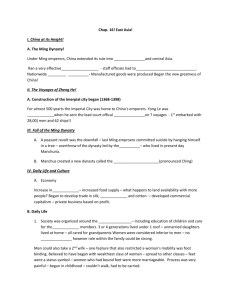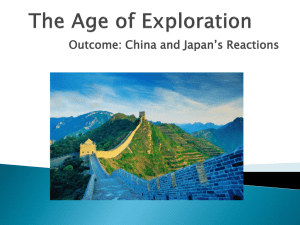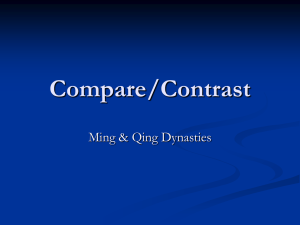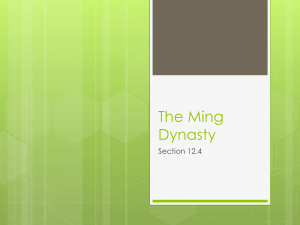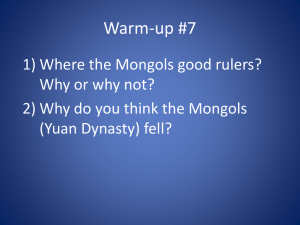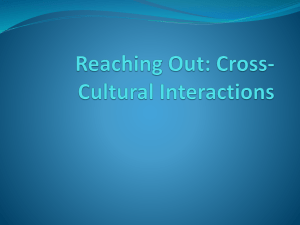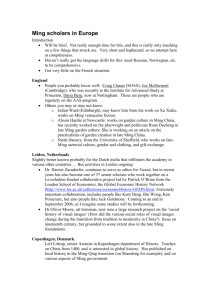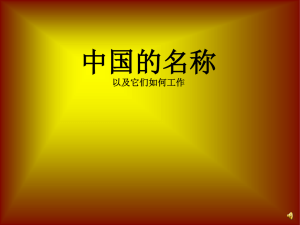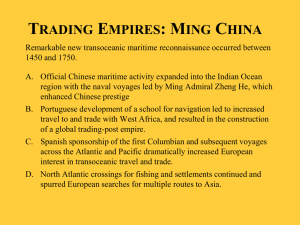The Recent Trends of Ming Studies In Mainland China
advertisement
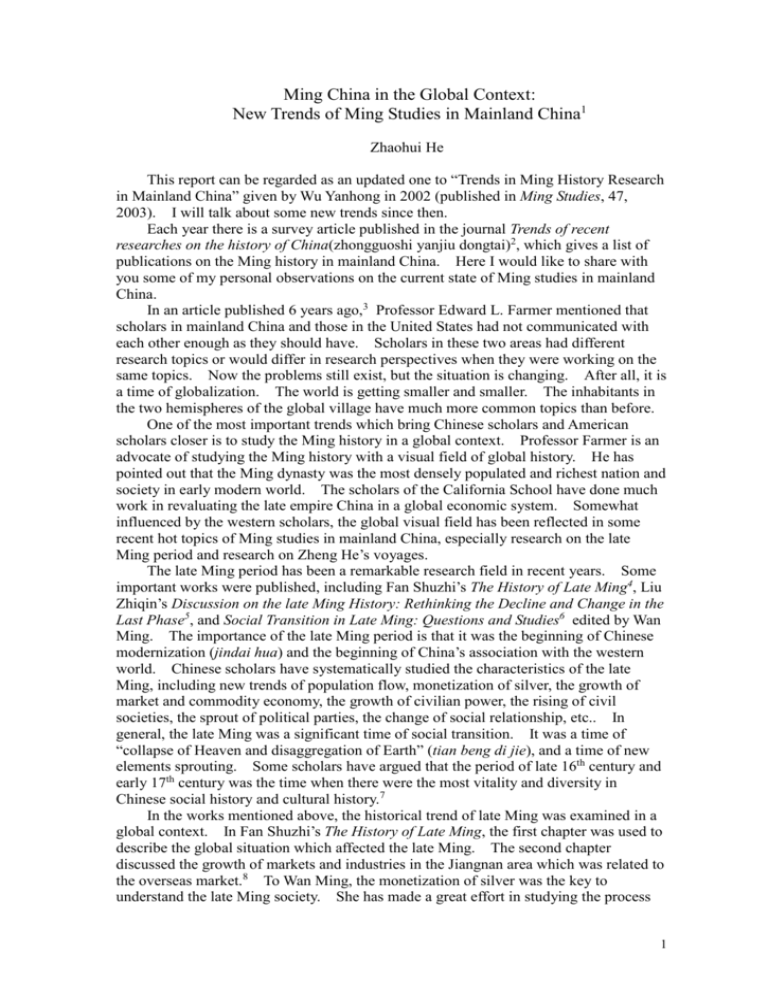
Ming China in the Global Context: New Trends of Ming Studies in Mainland China1 Zhaohui He This report can be regarded as an updated one to “Trends in Ming History Research in Mainland China” given by Wu Yanhong in 2002 (published in Ming Studies, 47, 2003). I will talk about some new trends since then. Each year there is a survey article published in the journal Trends of recent researches on the history of China(zhongguoshi yanjiu dongtai)2, which gives a list of publications on the Ming history in mainland China. Here I would like to share with you some of my personal observations on the current state of Ming studies in mainland China. In an article published 6 years ago,3 Professor Edward L. Farmer mentioned that scholars in mainland China and those in the United States had not communicated with each other enough as they should have. Scholars in these two areas had different research topics or would differ in research perspectives when they were working on the same topics. Now the problems still exist, but the situation is changing. After all, it is a time of globalization. The world is getting smaller and smaller. The inhabitants in the two hemispheres of the global village have much more common topics than before. One of the most important trends which bring Chinese scholars and American scholars closer is to study the Ming history in a global context. Professor Farmer is an advocate of studying the Ming history with a visual field of global history. He has pointed out that the Ming dynasty was the most densely populated and richest nation and society in early modern world. The scholars of the California School have done much work in revaluating the late empire China in a global economic system. Somewhat influenced by the western scholars, the global visual field has been reflected in some recent hot topics of Ming studies in mainland China, especially research on the late Ming period and research on Zheng He’s voyages. The late Ming period has been a remarkable research field in recent years. Some important works were published, including Fan Shuzhi’s The History of Late Ming4, Liu Zhiqin’s Discussion on the late Ming History: Rethinking the Decline and Change in the Last Phase5, and Social Transition in Late Ming: Questions and Studies6 edited by Wan Ming. The importance of the late Ming period is that it was the beginning of Chinese modernization (jindai hua) and the beginning of China’s association with the western world. Chinese scholars have systematically studied the characteristics of the late Ming, including new trends of population flow, monetization of silver, the growth of market and commodity economy, the growth of civilian power, the rising of civil societies, the sprout of political parties, the change of social relationship, etc.. In general, the late Ming was a significant time of social transition. It was a time of “collapse of Heaven and disaggregation of Earth” (tian beng di jie), and a time of new elements sprouting. Some scholars have argued that the period of late 16th century and early 17th century was the time when there were the most vitality and diversity in Chinese social history and cultural history.7 In the works mentioned above, the historical trend of late Ming was examined in a global context. In Fan Shuzhi’s The History of Late Ming, the first chapter was used to describe the global situation which affected the late Ming. The second chapter discussed the growth of markets and industries in the Jiangnan area which was related to the overseas market.8 To Wan Ming, the monetization of silver was the key to understand the late Ming society. She has made a great effort in studying the process 1 of the monetization of silver in the Ming dynasty and its relation with the world market9. According to Wan Ming, the demand of silver in China affected the exploitation of silver mines in Japan and America. The Ming China played an active role in the construction of a global market. Through this research, Chinese scholars have made contributions to illuminate the role China played in the early modern world system. In the field of social economic history, the significant change of social economic structure in the Jiangnan area in late Ming was reexamined when comparing with the early modern Europe. Rather than the traditional theory of “sprouts of capitalism”, many scholars now prefer other terms like “the formation of market economy” or “early industrialization”. The new interpretative frames reflect a vision field of a global system, and provide new platforms for dialogue with western scholarship. Wu Chengming, Jiang Xidong, Li Genpan and other scholars’ analysis of the characteristics of the economy in late empire China10 and Li Bozhong’s work11 have given some new perspectives in this area. Meanwhile there were also some different opinions from the hypothesis of the early modern global system and viewpoints on the California School. Li Xiantang has argued that the negative effects of silver on the Chinese economy cannot be neglected, and its role cannot be exaggerated12. In one article Zhao Yifeng has argued that there had not existed any divergence between China and Europe in early modern age at all as the histories of China and Europe had never combined before that13. When putting Ming China into a global context, scholars have considered how the Ming people looked at the rest of the world. Pang Naiming, Li Xiaolin and Xie Guian’s studies have examined the Chinese view of the outside world when China began to be a part of a world system14. This change of research angle is noticeable as it embodies the spirit of “discovering history in China”, comparing with earlier research focusing on the West’s intrusion and China’s responses. The year 2005 was the 600th anniversary of Zheng He’s voyages. This brought a rush of studies on Zheng He’s voyages in the recent several years. A series of scholarly conferences on Zheng He’s voyages were held. The proceedings of some conferences have been published15. Some retrospective works on Zheng He’s voyages were also published, including: Selected Papers on Zheng He in the last Century16, Selected Papers on Zhenghe’s Voyage(1905-2005)17, Collection of Documents on Zheng He’s Voyage(enlarged edition)18. Other works include Annotation of Ming Edition of The Overall Survey of the Ocean Shores (Yingya Shenglan)19 by Wan Ming, and Zheng Yijun’s The Full Biography of Zheng He20. The vision field of this global context has brought some new angles of the research on Zheng He’s voyages: the position of Zheng He's expeditions in the world maritime history, the rise and fall of Chinese sea power, the peaceful character of Zheng He's mission, Zheng He's influence in Southeast Asia and Middle East, etc. Comparisons have been made between Zheng He's expedition and the subsequent pioneering of new routes by the westerners, who brought about a global economic system while Zheng He did not. Many professional historians have doubted Gavin Menzies’ striking hypothesis, but it has simulated scholars to use broader research materials and to explore more possibilities. The use of overseas materials, including historical documents in foreign languages and overseas archaeological materials, will significantly expand the research field of Zheng He’s voyages in the future. Some important developments in other fields: In the field of political history and legal history, there was Zhang Xianqing and Lin Jinshu’s The Political History of Ming Dynasty21, Wu Yanhong’s Studies on the Military Exile in the Ming Dynasty22, and Bai Hua’s two books on the local administration in the Ming dynasty23. The routines of 2 people’s daily life in the Ming has aroused scholars’ interests in recent years. In 2004 an important book appeared in this field, Chen Baoliang’s The Social Life in the Ming Dynasty24. A related work was Fang Zhiyuan’s Cities and Civilian Literature in the Ming Dynasty25. Chang Jianhua’s Studies on the Lineage in the Ming Dynasty26 was the distillate of many years’ work in this field. Xie Guian’s Studies of Ming Shilu27 was an important study on the huge official history of the Ming dynasty. Zhu Honglin’s Studies on the Works and Lives of Ming People28 is a textual research on some works in the Ming period. Endnotes: 1 First I would like to thank Professor Edward L. Farmer and Professor Ann Waltner, who made my visit to the United States possible. And I am grateful to the Society for Ming Studies and the Center for Early Modern History of the University of Minnesota, which supported me to give a speech at the annual meeting of the Association for Asian Studies on which this article based. 2 Zhang Jinkui, “Survey of Ming studies in 2003”, Trends of recent researches on the history of China (Zhongguoshi yanjiu dongtai), No. 5, 2004; Zhang Jinkui, “Survey of Ming studies in 2004”, Trends of recent research on the history of China (Zhongguoshi yanjiu dongtai), No. 4, 2005. 3 Edward L. Farmer, “New trends of Ming studies in the English world in recent years”, Trends of recent researches on the history of China (Zhongguoshi yanjiu dongtai), No. 1, 2000. 4 Fan Shuzhi, The History of the Late Ming (Wan ming shi), Fudan University Press, 2003. 5 Liu Zhiqin, Discussion on the late Ming History: Rethinking the Decline and Change in the Last Phase (Wan ming shi lun: chongxin renshi moshi shuaibian), Jiangxi Universities and Colleges Press, 2004. 6 Wan Ming, ed. Social Transition in Late Ming: Questions and Studies (Wan ming shehui bianqian: wenti yu yanjiu), Commercial Press, 2005. 7 Zhang Xianqing, Wan Ming, Chen Baoliang, etc., Discussion of “Studies on the social and cultural transition in the late Ming”, Chinese Culture Studies (Zhongguo wenhua yanjiu), Vol. Spring, 2004. 8 See also: Fan Shuzhi, “The late Ming in the vision of ‘globalization’”, Fudan Journal (Philosophy and Social Sciences) (Fudan xuebao), No. 1, 2003. 9 Wan Ming, “Primary observation on monetization of silver in the Ming dynasty”, Research in Chinese Economic History (Zhongguo jingji shi yanjiu), No.2, 2003; Wan Ming, “Monetization of Silver in the Ming Dynasty: New Visual Angle of the Connection of China and the World”, Hebei Academic Journal (Hebei xuekan), No.3, 2004. 10 Wu Chengming, Jiang Xidong, Li Genpan, etc., Discussion on “Revaluation of the traditional economy”, Researches in Chinese Economic History (Zhongguo jingji shi yanjiu), No.1, 2003. 11 Li Bozhong, Observations of the Economic History of the Jiangnan Area from Multiple Angles(1250-1850 )(Duo jiaodu kan jiangnan jingji shi), Joint Publishing, 2003. 12 Li Xiantang, “The dual effects of silver on the Ming and Qing Economy—review on the myth of “global economy” cooked up by Frank and Pomeranz, Hebei Academic Journal (Hebei xuekan), No.2, 2005. 13 Zhao Yifeng, “Divergence or concourse: the civilization perspective of history on the historical trends in Ming and Qing”, Journal of Northeast Normal University (Dongbei shida xuebao), No.1 2005. 14 Pang Naiming, “Observations on Ming people’s opinions about Portuguese”; Li Xiaolin, “The limitation of Ming people’s cognition of Japan”; Xie Guian, “The input of Western appliance and its social effects in the Ming dynasty”, The 11th international conference of Ming studies, Lanzhou & Xining, Aug. 2005. Xie Guian, “The input of Western appliance in the Ming dynasty and pre-modern Chinese society”, Academic Monthly (Xueshu yuekan), No.8, 2003 15 Carry on Civilization, Open to the World, for Peace and Development: Proceedings of International Academic Forum in Memory of the 600th Anniversary of Zhenghe’s Expedition (Chuancheng wenming, zouxiang shijie, heping fazhan: jinian zhenghe xia xiyang 600 zhounian guoji xueshu luntan lunwen ji), Social Sciences Archives Press, 2005; Wang Tianyou, Xu Kai, Wan Ming, ed., Zheng He’s Voyages and World Civilization: Proceedings in Memory of the 600 th Anniversary of Zheng He’s Expedition (Zheng He yuanyang yu shijie wenming: jinian zhenghe xi xiyang 600 zhounian lunwen ji), Peking University Press, 2005. 16 Wang Tianyou, Wan Ming, ed., Selected Papers on Zheng He in the last Century (Zheng He yanjiu bainian lunwen xuan), Peking University Press, 2004. 3 Selected Papers on Zheng He’s Voyage(1905-2005)(Zheng He xia xiwang yanjiu wenxuan), Sea Press, 2005. 18 Zheng Yijun, Collection of Documents on Zheng He’s Voyage (Enlarged edition)(Zheng He xia xiyang ziliao huibian (zengbian ben)), Sea Press, 2005. 19 Wan Ming, Annotation of Ming Edition of The Overall Survey of the Ocean Shores (Yingya Shenglan) (Ming chaoben ‘yingya shenglan’ jiaozhu), Sea Press, 2005. 20 Zheng Yijun, The Full Biography of Zheng He (Zheng He quan zhuan), Chinese Youth Press, 2005. 21 Zhang Xianqing, Lin Jinshu, The Political History of Ming Dynasty (Mingdai zhengzhi shi), Guangxi Normal University Press, 2003. 22 Wu Yanhong, Studies on the Military Exile in the Ming Dynasty (Mingdai chongjun yanjiu), Social Sciences Archives Press, 2003 23 Bai Hua, Studies on the Sub-prefecture and County System in the Ming Dynasty (Mingdai zhouxian zhengzhi tizhi yanjiu),China Social Sciences Press, 2003; Bai Hua, The Sub-prefecture and County Magistrates in Ming and Qing (Ming qing zhouxian guan qunti), Tianjin People Press, 2003. 24 Chen Baoliang, The Social Life in the Ming Dynasty (Mingdai shehui shenghuo shi), China Social Sciences Press, 2004. 25 Fang Zhiyuan, The Cities and Civilian Literature in the Ming Dynasty (Mingdai chengshi yu shimin wenxue), Zhonghua Book Company, 2004. 26 Chang Jianhua, Studies on the Lineage in the Ming Dynasty (Mingdai zongzu yanjiu), Shanghai People Press, 2004. 27 Xie Guian, Studies of Ming shilu (Ming shilu yanjiu), Hubei People Press, 2003. 28 Zhu Honglin, Studies on the Works and Lives of Ming People (Mingren zhuzuo yu shengping fawei), Guangxi Normal University Press, 2005. 17 4
